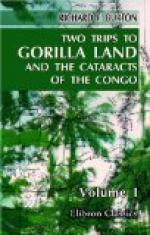We shall ascend the Gaboon estuary to its sources. South of it, a number of sweet little water-courses break the shore-line as far as the Nazareth River, which debouches north of Urungu, or Cape Lopez (Cabo de Lopo Gonsalvez), and which forms by anastomosing with a southern river the Ogobe (Ogowai of M. du Chaillu), a complicated delta whose sea-front extends from north to south, at least eighty miles. Beyond Cape Lopez is an outfall, known to Europeans as the Rio Mexias: it is apparently a mesh in the net-work of the Nazareth-Ogobe. The same may be said of the Rio Fernao Vaz, about 110 miles south of the Gaboon, and of yet another stream which, running lagoon-like some forty miles along the shore, has received in our maps the somewhat vague name of R. Rembo or River River. Orembo (Simpongwe) being the generic term for a stream or river, is applied emphatically to the Nkomo branch of the Gaboon, and to the Fernao Vaz.
The Ogobe is the only river between the Niger and the Congo which escapes, through favouring depressions, from the highlands flanking the great watery plateau of Inner Africa. By its plainly marked double seasons of flood at the equinoxes, and by the time of its low water, we prove that it drains the belt of calms, and the region immediately upon the equator. The explorations of Lieutenant Serval and others, in “Le Pionnier” river-steamer, give it an average breadth of 8,200 feet, though broken by sand-banks and islands; the depth in the main channel, which at times is narrow and difficult to find, averages between sixteen and forty-eight feet; and, in the dry season of 1862, the vessel ran up sixty English miles.
Before M. du Chaillu’s expeditions, “the rivers known to Europeans,” he tells us in his Preface ("First Journey,” p. iv.), “as the Nazareth, Mexias, and Fernam Vaz, were supposed to be three distinct streams.” In 1817 Bowdich identified the “Ogoowai” with the Congo, and the Rev. Mr. Wilson (p. 284) shows us the small amount of knowledge that existed even amongst experts, five years before the “Gorilla book” appeared. “From Cape Lopez, where the Nazareth debouches, there is a narrow lagoon running along the sea-coast, and very near to it, all the way to Mayumba. This lagoon is much traversed by boats and canoes, and, when the slave-trade was in vigorous operation, it afforded the Portuguese traders great facilities for eluding the vigilance of British cruizers, by shifting their slaves from point to point, and embarking them, according to a preconcerted plan.”
M. du Chaillu first proved that the Ogobe was formed by two forks, the northern, or Rembo Okanda, and the southern, or Rembo Nguye. The former is the more important. Mr. R.S.N. Walker found this stream above the confluence to be from 1,800 to 2,100 feet wide, though half the bed was occupied by bare sand-banks. Higher up, where rocks and rapids interfered with the boat-voyage, the current was considerable, but the breadth diminished to 600 feet. The southern branch (also written Ngunie) was found in Apono Land (S. lat. 2deg.), about the breadth of the Thames at London Bridge, 700 feet. In June the depth was ten to fifteen feet, to which the rainy season added ten.




